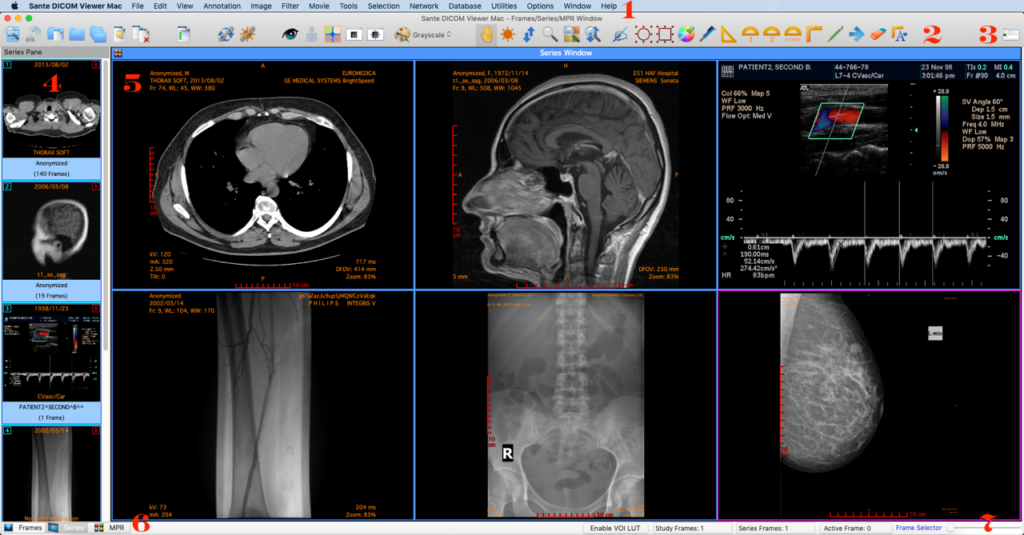Medical imaging data stored in the DICOM (Digital Imaging and Communications in Medicine) format allows medical professionals to view and analyze scans like X-rays, MRIs, and CT scans on PCs.
However, as image resolution and accuracy improve, file sizes increase. So how does DICOM viewer free handle large datasets without advanced hardware? We’ll find out.
Medical images take up significant storage space due to increased quality demands. A single uncompressed CT scan can require several gigabytes.
Viewing these complex volumetric pictures taxes hardware and software capabilities. We’ll break down common methods free DICOM viewers use to work effectively.
| Viewer | Compression | Streaming | Selective Loading |
| eFilm | Yes | No | Yes |
| Weasis | Yes | Yes | No |
Introducing Data Compression
The most universal tactic utilizes data compression to shrink files for transmission and storage. DICOM incorporates both lossless and lossy techniques:
- Lossless compression reduces file size without losing data. It commonly cuts the data down 2:1.
- Lossy compression creates smaller files by eliminating unnecessary info. This allows higher compression ratios but risks losing critical data.
Free DICOM software sticks to lossless compression, as patients require every detail preserved. The process happens invisibly, shrinks images sufficiently for budget hardware capabilities, and expands them to full size for viewing.
Streaming Data Loads Sections As Needed
Streaming incrementally transfers just enough data to display the current image region examined. Instead of loading an entire scan upfront, streaming pulls sections from the source when users pan/zoom on an area.
This prevents free viewers bogging down systems by keeping the memory footprint small. It does lead to lag when changing views rapidly. Budget systems also require storing images on a server, not locally, to enable streaming.
Selective Region Loading Removes Unneeded Data
Selective region loading improves responsiveness by ignoring unneeded areas. Viewing software analyzes volume info to load only essential sections upfront. Irrelevant data stays untouched until accessed.
For example, when viewing a CT head scan, only the head requires loading initially. Limbs and organs below the region of interest get skipped. This reduces wait times when opening files and allows smoother navigation even on low-end hardware.
Dicom viewer free options leverage these approaches to balance capabilities and limitations. Now let’s examine the trade-offs:
Speed and Performance Restrictions
Free DICOM solutions prize minimal hardware requirements for accessibility. However, optimizing for compatibility over speed does involve compromises:
- Increased lag when changing views rapidly
- Choppy playback for cine loops
- Lengthy scan initialization delays
Streaming prevents freezing up systems but adds minor view change delays. Cine loops allow videos of contrast dye flows to diagnose dynamic issues. Playback requires preloading then playing frames fast, taxing cheap hardware.
There are also initialization lags when identifying scan dimensions, adjusting images, and preparing the first view. This wait can exceed a minute for enormous scans on underpowered machines.

Handling Advanced Visualization and Analysis
Many crucial medical imaging tasks require manipulating volumetric data in complex ways normal viewers don’t allow. Doctors may need to:
- Isolate blood vessels with subtraction tools
- Highlight anatomy differences over time
- Model simulated surgery outcomes
- Register multimodal scans into a composite view
While free options work for everyday viewing, physicians requiring advanced 3D renderings, image analysis, surgical planning systems, or research tools need more robust commercial systems with fewer constraints.
Lacking Configuration Options
Free viewers emphasize usability for novices. This comes at the cost of customization options technical users expect like:
- Adjustable memory/streaming buffers
- Configurable format handling
- User interface modifications
- Extensibility via plugins
Skilled users must work around issues or miss functionality they could solve with commercial flexible viewers. However, open source tools at least enable direct code modifications.
When Are Free Viewers Sufficient?
Free DICOM solutions allow basic viewing needs but have limitations. They work well when:
- Budget constraints make commercial options unfeasible
- Quick emergency department diagnoses require only a few views
- Remote specialists need external access to images
- Patients want to view their own records
- Small clinics can’t justify advanced visualization tools
The compressed streaming and selective loading in free packages handles sufficiently massive data volumes for many fundamental use cases. But doctors should understand the trade-offs between commercial and freely available options.


